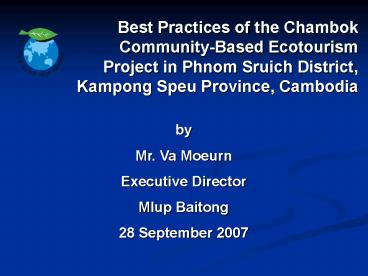CHAMBOK CBET - PowerPoint PPT Presentation
1 / 11
Title:
CHAMBOK CBET
Description:
... Ecotourism Project in Phnom Sruich District, Kampong Speu Province, Cambodia ... MB itself has started to replicate the concept in other places of Cambodia. ... – PowerPoint PPT presentation
Number of Views:229
Avg rating:3.0/5.0
Title: CHAMBOK CBET
1
Best Practices of the Chambok Community-Based
Ecotourism Project in Phnom Sruich District,
Kampong Speu Province, Cambodia
by Mr. Va Moeurn Executive Director Mlup
Baitong 28 September 2007
2
PROJECT BACKGROUND
- Low agricultural yields (1t/ha) and limited farm
land (0.5 ha/ family), Most Chamboks community
(94) depend on forest resources for their
livelihood (forest extraction activities). - These activities include felling trees for
timber, charcoal and fuel wood production,
non-timber forest product collection and wildlife
hunting. - These activities have been unmanaged
uncontrolled and have led to deforestation and
severe degradation of wildlife resources. - In 2002 Mlup Baitong Green Shade established
Chambok CBET Project capitalizing the existing
natural resources including a 30 meter waterfall
and a beautiful forest landscape for tourist
attraction. - The project is to empower communities to manage
more than 1100 hectares of forest land through
CBET approach, which benefited 500 households of
9 villages of Chambok Commune.
3
PROJECT DESCRIPTION
- Agreement was signed between Mlup Baitong and MoE
to official grant the forest land (800 ha) in a
Protected Area. - Training on environmental topics provided and
introduction of idea of an ecotourism project
promoted. - A CBET Management Committee and its bylaw, rules,
and regulation for governing the site
established. - Goal and objectives of Chambok CBET defined
- Once the site declared safe from landmines, the
construction of all necessary infrastructures and
facilities began, - Training on relevant basic skills provided.
- The project was officially opened to the public
in 2003.
4
PROJECT GOAL AND OBJECTIVES
- Project goal To empower the people of Chambok to
actively participate in sustainable management of
natural resources in the site for their
livelihood development and poverty reduction. - Project Objectives
- Protect forests and natural resources of Chambok,
- Provide income generating alternatives to poor
and forest-products-dependent families in the
community. - Educate the local people and visitors about
environmental conservation.
5
KEY ELEMENT OF THE PROJECT
- The Chambok CBET Project are divided into five
main components - Construction, renovation and maintenance of
infrastructure and facilities. - Building the capacity of the CBET Management
Committee (MC) members and service providers. - Establishment and marketing of income generation
services - Keeping the eco-tourism site environmentally
friendly - Formation of Women SHG and the development of
micro-businesses.
6
PROJECT DURATION AND COST
- The project has been implemented for a nine-year
period from 2002 to 2009. - The total project investment was 226,000.
- All project costs have been funded by foreign
donors including Oxfam Novib, SCIAF, OGB, KNCF,
ADB, Blacksmith Institute, Canada Fund, McKnight
Foundation, UNDP/EC SGP, and other donations. - However, the government contributed some support
to the building of roads and landmine clearance,
while tour companies assisted with advertisement.
7
PROJECT OUTCOMES AND IMPACTS
- The project has achieved a number of major
outcomes in terms of biodiversity conservation,
livelihood development and project
sustainability. - More than 1,100 ha of forest, with an estimated
economic value of more than 1 million USD, is now
properly managed and protected. - Elimination of 72 charcoal kilns has given the
forest a proper chance to regenerate. - Illegal forest activities were reported that have
been reduced considerably. - Many villagers previously involved in logging or
hunting have become forest protector, permanent
farmers, tour guides or tourism service
providers.
8
PROJECT OUTCOMES AND IMPACTS (cont)
- Non-timber forest resources have become more
abundant benefiting the 500 households - The villagers were able to gain income from
selling agricultural and other local products. - 300 people (200 are women representing 66 ) have
been employed on a rotational basis which provide
additional incomes of around 40USD/family/ year
(nearly to 10 of yearly income). - By taking on the responsibilities of project
activities, women become more empowered. - In 2006, the total revenue generated is more than
10,000. - Many intangible values developed
- Chambok CBET is recognized by the Ministry of
Tourism as a unique example in Cambodia. - 47 national and international delegations visited
the site between January 2006 and June 2007.
9
CHALLENGES
- Low level of education among villagers is a major
obstacle for project implementation. MB spent a
significant amount of time building capacities of
the MC members. Sometimes, training sessions
delivered repeatedly. - Difficult to persuade villagers, MC members and
local authorities and tourists to adapt to the
innovative approaches and procedures. - Difficult to protect the forest in and around the
site from logging, hunting, forest fires,
forestland encroachment, and clearance. - But owing persistent effort of MB to raise
awareness of nature conservation through
cooperation with all stakeholders, effective
mechanisms were established.
10
LESSONS LEARNED
- An effective CBET MC and appropriate bylaws, and
regulation for governing the project need to be
clearly established through a participatory
approach to ensure the ownership of the project. - Capacity building for MC and tourism service
providers has to be done repeatedly if necessary
to ensure the sustainability of the project. - Equal opportunity for involvement and equitable
sharing of benefits among community members have
to be carefully taken into account during project
implementation in order to avoid internal
conflict.
11
CONCLUSION
- Chambok CBET is generally viewed as a model of
best practices for Community Based Eco-tourism in
Cambodia. - The concept of CBET developed in Chambok has
already been an example for many other
organizations for similar project. - MB itself has started to replicate the concept in
other places of Cambodia.

